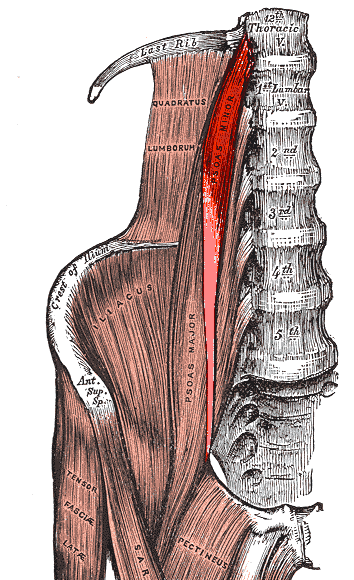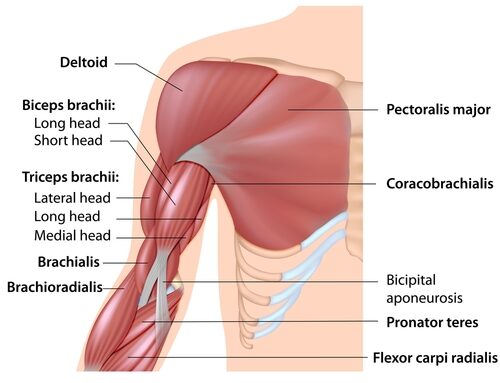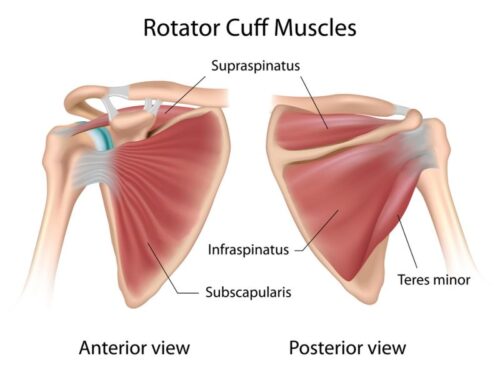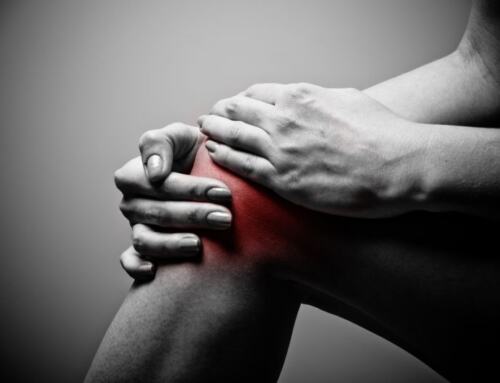The Psoas Muscle: Unlocking the Secrets to Back Pain Relief

The psoas muscle, often overlooked in discussions about back pain, plays a pivotal role in the health of our spine and lower back. This unassuming muscle, buried deep within the core of our bodies, can be a silent culprit behind chronic discomfort and postural issues. In this comprehensive guide, we will talk about the intricate world of the psoas muscle, exploring its anatomy, function, and the crucial role it plays in maintaining a pain-free back. If you’ve ever wondered about the connection between your psoas muscle and back pain or how to strengthen and stretch it for better health, this article is a must-read.
Unveiling the Psoas Muscle: Anatomy and Function
Anatomy of the Psoas Muscle
The psoas muscle, also referred to as the iliopsoas, is a remarkable structure. It’s a long muscle that originates from the vertebral bodies and intervertebral discs of the lumbar spine. This muscular bundle crosses the pelvis and attaches to the lesser trochanter of the femur, effectively connecting the lower spine to the thigh bone. This attachment point near the hip joint gives this muscle its unique ability to flex the hip, allowing us to lift our legs.
Function of the Psoas Muscle
The psoas plays a crucial role in activities as basic as walking, running, and standing. Without a properly functioning psoas, these activities would be cumbersome or impossible. When the psoas contracts, it flexes the hip, which is fundamental to movements like walking and running. Additionally, it helps stabilize the spine and maintain proper alignment.

Recognizing Symptoms of Psoas Dysfunction
Psoas dysfunction can manifest in various ways, and understanding the symptoms associated with it is vital for early recognition and effective management. Here are some common signs and symptoms of psoas dysfunction:
1. Hip Pain: One of the hallmark symptoms of psoas dysfunction is hip pain. This discomfort is often described as a dull ache or discomfort in the groin area, radiating from the front of the hip joint. It may be more pronounced on one side, typically the side of the affected psoas muscle.
2. Groin Pain: Psoas dysfunction can also cause pain in the groin region, which can be mistaken for other conditions. This pain often feels deep and may be exacerbated by movements that engage the psoas, such as hip flexion. [Read more about groin pain]
3. Altered Gait: When the psoas muscle is tight or dysfunctional, it can affect your gait or the way you walk. Individuals with psoas issues may notice a limp or an uneven stride, particularly when the affected leg is involved. This altered gait is an indicator of muscle imbalance.
4. Pelvic Pain: Psoas dysfunction can contribute to pelvic pain, which may vary in intensity. It’s important to differentiate between psoas-related pelvic pain and other causes, such as issues with pelvic organs.
5. Lower Back Pain: The psoas muscle’s attachment points in the lumbar region mean that dysfunction can result in lower back pain. This pain can range from mild discomfort to chronic lower back pain.
6. Tight Hamstrings: Tightness or discomfort in the hamstrings, the muscles at the back of the thigh, can be linked to psoas dysfunction. The psoas and hamstrings are part of a muscle group that works together for hip movement and stability.
7. Abdominal Pain: The psoas muscle lies in close proximity to abdominal organs. Dysfunction in this muscle can sometimes lead to referred abdominal pain, which may be confused with internal organ issues. It’s essential to consider psoas dysfunction when assessing abdominal pain, particularly if other causes have been ruled out.
8. Gastrointestinal Symptoms: In some cases, psoas dysfunction may be associated with gastrointestinal discomfort. While not directly related to the muscle, psoas dysfunction can sometimes lead to functional leg length discrepancy, which may impact the alignment of the pelvis and spine.
9. Chronic Hip Issues: Individuals with chronic hip problems, such as iliopsoas bursitis or iliopsoas syndrome, may experience ongoing discomfort and mobility limitations due to psoas dysfunction.
10. Posture Abnormalities: Psoas dysfunction can contribute to poor posture, including an anterior pelvic tilt, which affects the alignment of the spine and pelvis. [What to do for better posture]
Recognizing these symptoms is the first step in addressing psoas dysfunction effectively. If you experience any of these signs, particularly if they persist over a long time or are accompanied by other concerning symptoms, seeking medical advice, including consultation with a physical therapist or healthcare professional, is the best way to determine the underlying cause and develop a tailored treatment plan. Early intervention can prevent chronic issues and help you regain your mobility and comfort.
Identifying Common Causes of Psoas Tightness
Understanding the factors behind psoas tightness is essential for recognizing potential triggers of discomfort and taking proactive steps to maintain a healthy psoas muscle. This muscle, often considered one of the most important muscles in the body, can become tight due to various reasons. Here are some common causes:
1. Sedentary Lifestyles: In today’s fast-paced world, many individuals, particularly office workers, spend long periods of time in a seated position. Prolonged sitting can lead to psoas tightness, as this muscle remains in a shortened state and lacks the opportunity to stretch and relax. Sitting is the new smoking. “The American Cancer Society did a study that showed women that sat for more than six hours a day had a 37% increased risk of dying compared to those that sat for three hours a day.”
2. Repetitive Movements: Certain professions or activities, such as field athletes or long-distance runners, involve repetitive motions that can strain the psoas muscle. Overuse without adequate rest and recovery may result in muscle tightness.
3. Poor Posture: Maintaining poor posture, characterized by an anterior tilt of the pelvis and a flattened lumbar spine, can contribute to psoas tightness. This is especially common among those who sit for extended periods without proper ergonomic support.
4. Emotional Stress: Emotional stress can manifest physically, leading to muscle tension, including in the psoas. The body’s nervous system response can cause the psoas to contract, resulting in persistent tightness and discomfort.
5. Previous Injuries: Injuries to the lumbar region or the pelvic area can disrupt the balance and function of the psoas muscle. Scar tissue and compensatory movements may lead to tightness as the body tries to protect itself.
6. Lack of Exercise: A sedentary lifestyle or neglecting specific exercises to target the psoas and other core muscles can result in muscle imbalances. Inactivity can cause the psoas to weaken and become prone to tightness.
Recognizing these common triggers for psoas tightness is the first step in addressing the issue. If you experience symptoms of a tight psoas muscle, such as lower back pain, hip pain, or groin pain, it’s essential to seek medical advice. A physical therapist or a healthcare professional can conduct a thorough physical exam and recommend specific exercises or treatments, such as lunge stretches or the constructive rest position, to alleviate psoas issues.
The good news is that with the right approach, including physical therapy and targeted exercises, you can restore normal function to your psoas muscles and enjoy good posture and reduced discomfort. Don’t let psoas tightness hold you back; take action today to maintain a healthy, functional psoas muscle.
Medical Conditions and Their Impact on the Psoas Muscle
Understanding the relationship between medical conditions and the psoas muscle is essential for gaining insight into potential complications and challenges that individuals may face. While the psoas muscle is primarily associated with posture, movement, and musculoskeletal health, it can be affected by various medical conditions or injuries. Here are some medical conditions and scenarios that can impact the psoas muscle:
1. Psoas Abscess: A psoas abscess is a rare but serious condition characterized by the accumulation of pus within the psoas muscle. This can lead to significant psoas muscle pain, discomfort, and restricted movement. Treatment typically involves drainage and antibiotics.
2. Psoas Tendonitis: Inflammation of the tendon, known as psoas tendonitis, can cause pain and discomfort in the front of the hip socket or groin area. This condition can affect individuals who engage in repetitive hip flexion activities or sports.
3. Colon Cancer: In some cases, colon cancer can cause symptoms that refer pain to the hip and psoas region. It’s essential to differentiate between psoas-related discomfort and potential medical issues.
4. Total Hip Replacement: Individuals who undergo total hip replacement surgery may experience changes in muscle tension and alignment, including the psoas muscle. Rehabilitation and physical therapy play a crucial role in restoring function and mobility.
5. Hip Arthritis: Hip arthritis can result in chronic hip pain, which may affect the function and flexibility of the psoas muscle. Managing hip arthritis often involves a combination of medical treatment and physical therapy.
6. Car Accidents: Traumatic incidents, such as a car accident, can lead to various injuries, including those affecting the psoas muscle. These injuries may require comprehensive evaluation and treatment.
7. Psoas Strain: A psoas strain refers to an injury to the psoas muscle or its tendons. It can occur due to sudden movements, overuse, or excessive stretching. Symptoms include pain, weakness, and limited mobility in the hip and lower back.
8. Iliopsoas Bursitis: Bursitis is the inflammation of a bursa sac, a small fluid-filled sac that cushions and reduces friction between tendons, ligaments, and bones. When the bursa sac near the iliopsoas muscle becomes inflamed, it can lead to iliopsoas bursitis, causing pain and discomfort.
9. Functional Leg Length Discrepancy: Dysfunction in the psoas muscle can lead to a functional leg length discrepancy, where one leg appears shorter than the other due to altered hip and pelvic alignment. [Leg Length Differences]
10. Menstrual Cramps: Some individuals may experience increased psoas muscle tension and discomfort during menstruation, which can contribute to menstrual cramps and pelvic pain.
Understanding how medical conditions or injuries can impact the psoas muscle is vital for healthcare professionals and individuals alike. It allows for a more holistic approach to diagnosis, treatment, and rehabilitation. If you suspect that a medical condition or injury is affecting your psoas muscle or causing psoas pain symptoms, it’s essential to consult with a healthcare provider for a thorough evaluation and a tailored treatment plan.
Stretching and Strengthening the Psoas: Key Techniques
Stretching the Psoas Muscle
One of the primary methods for addressing psoas-related issues is through targeted stretching exercises. These stretches aim to lengthen the psoas muscle, reducing tension. Common psoas stretches include the kneeling lunge and the supine psoas stretch. Regularly incorporating these stretches into your routine can help alleviate psoas-related discomfort.
Strengthening the Psoas Muscle
In addition to stretching, strengthening the psoas muscle is crucial for maintaining overall back health. Strengthening exercises, such as leg raises and lying leg lift exercises and pelvic tilts, can help ensure that the psoas remain balanced and capable of supporting the spine. A strong psoas muscle can better counteract the forces that pull on the lower back.

The Psoas Muscle’s Role in Spinal Health
Psoas and Spinal Alignment
The spine is the central support structure of the human body, and the psoas muscle plays an integral role in maintaining its health. A properly functioning psoas helps keep the lumbar spine in proper alignment, reducing the risk of spinal issues. When the psoas muscle is balanced and flexible, it contributes to a healthy, pain-free spine.
Preventing Disc Issues
Furthermore, the psoas muscle’s role in spinal health extends to the prevention of disc issues. By providing stability to the lumbar spine, it reduces the risk of disc herniation and other degenerative conditions. Maintaining a strong and flexible psoas muscle is a proactive step in preserving the health of your spine.
The Iliopsoas Muscle: The Dynamic Duo
The Psoas Major and Iliacus Muscles
The iliopsoas is often referred to as the “hip flexor” and is composed of two distinct muscles: the psoas major and the iliacus. This group of muscles works in harmony to perform hip flexion and contribute to deep core muscle stability. Understanding their individual functions is essential for maintaining balanced musculature.
Hip and Core Stability
The psoas major primarily focuses on hip flexion, whereas the iliacus assists in this action. Together, they allow you to lift your legs and perform various activities, including walking, running, and climbing stairs. Additionally, they play a vital role in stabilizing the inner core, helping maintain an upright posture.
The Psoas Muscle’s Fascial Relationship
The Fascial Network
Fascia is a connective tissue network that envelops and interconnects muscles throughout the body. The psoas muscle has a complex fascial relationship, making it a critical component of this intricate network. Understanding how the psoas interacts with fascia sheds light on the far-reaching effects of psoas health on overall bodily function.
Massage Therapy: A Soothing Solution for Psoas Tightness
Massage therapy has long been recognized as a valuable tool in addressing various musculoskeletal issues, including psoas tightness. When it comes to the psoas muscle, the benefits of massage can be particularly pronounced. Here’s how massage can provide pain relief and contribute to overall well-being:
1. Targeted Release of Tension: Skilled massage therapists can pinpoint the psoas muscle and apply specialized techniques to release tension. Through gentle kneading and pressure, they work to loosen the muscle, promoting relaxation and improved flexibility.
2. Improved Blood Circulation: Massage stimulates blood flow to the targeted area, which can help reduce inflammation and promote healing. This increased circulation ensures that the psoas muscle receives the nutrients and oxygen it needs for optimal function.
3. Enhanced Range of Motion: Psoas tightness often limits hip range of motion, leading to discomfort and restricted movement. Regular massage sessions can gradually increase your range of motion by lengthening the psoas muscle and its associated tissues.
4. Pain Reduction: Individuals experiencing psoas-related discomfort, including lower back pain, often find relief through massage therapy. The release of tension in the psoas muscle can alleviate pressure on the lumbar spine, reducing pain and discomfort.
5. Stress Reduction: Stress can contribute to muscle tension, including in the psoas. Massage is known for its stress-relieving benefits, which can indirectly help relax the psoas muscle. A relaxed psoas is less prone to issues.
6. Improved Posture: Prolonged psoas tightness can lead to postural imbalances. Regular massage sessions can contribute to better posture by addressing the underlying muscle tension and promoting proper alignment.
7. Complement to Stretching and Strengthening: While exercises are crucial for long-term psoas health, massage can complement these efforts. Massage can help release stubborn knots and trigger points, making it easier to engage in effective exercise routines.
When seeking massage therapy for psoas pain, it’s essential to consult with a qualified and experienced therapist like the ones at Body Ache Escape Massage Center who understands the intricacies of the psoas muscle. They can tailor their techniques to your specific needs, helping you find relief from discomfort, ultimately contributing to a healthier, more flexible, and pain-free psoas muscle.
Q: What is the role of the psoas muscle?
A: The psoas muscle plays a crucial role in connecting the upper body with the lower body. It is responsible for flexing the hip joint, stabilizing the spine, and supporting proper posture.
Q: Where is the psoas muscle located?
A: The psoas muscle is located deep within the abdomen, near the front of the lumbar spine, and runs through the lower back down to the upper thighs.
Q: How does a tight psoas muscle affect the body?
A: A tight psoas muscle can cause various issues such as lower back pain, hip pain, limited range of motion, poor posture, and even affect organ function due to its close proximity to vital internal organs in the abdomen.
Q: What are some exercises for the psoas?
A: Some exercises to stretch and strengthen the psoas muscle include lunges, leg lifts, hip flexor stretches, bridge exercises, and yoga poses such as the “warrior” pose.
Q: Is the psoas muscle associated with low back pain?
A: Yes, a tight or weak psoas muscle is often associated with low back pain. When the psoas muscle is imbalanced or dysfunctional, it can cause strain on the lower back and contribute to chronic pain.
Q: What other muscles are associated with the psoas?
A: The psoas muscle combines with the iliacus muscle in the pelvis to form the iliopsoas muscle. Additionally, the psoas muscle works in conjunction with muscles such as the quadratus lumborum and the gluteal muscles to provide stability and mobility to the lower body.
Q: How can I stretch my psoas muscle?
A: To stretch your psoas muscle, you can try exercises such as the kneeling lunge stretch, hip flexor stretch, or the supine psoas release stretch. It is important to perform these stretches with proper form and guidance to avoid injury.
Q: What is the function of the psoas minor muscle?
A: The psoas minor muscle is a smaller muscle located deep within the abdomen and has a limited role in hip flexion. It is not as commonly implicated in back pain or dysfunction as the psoas major muscle.
Q: How does the psoas muscle contribute to muscle imbalances?
A: When the psoas muscle is tight or weak, it can create muscle imbalances in the body. It may lead to overactivity or compensatory patterns in other muscles, such as the lower back muscles or the hip flexors.
Q: What is the insertion point of the psoas muscle?
A: The psoas muscle inserts on the head of the femur, which is a bony prominence located on the inner side of the upper thigh bone.
In Conclusion
The psoas muscle, often underestimated and overlooked, plays an indispensable role in our daily lives. From helping us stand upright to taking each step, this muscle is constantly at work. Understanding the relationship between the psoas muscle and back pain is the first step in achieving a pain-free life.
If you’ve been experiencing psoas-related discomfort, now is the perfect time to take action and prioritize your well-being. One effective way to address psoas tightness and promote relaxation is through massage therapy.
At Body Ache Escape Massage Center, our skilled massage therapists specialize in techniques that release tension, improve blood circulation, and enhance your overall sense of well-being. By scheduling a massage, you can experience the healing benefits of targeted psoas muscle therapy.
Don’t let psoas-related issues hold you back any longer. Take the first step toward a pain-free and mobile life by booking your massage at Body Ache Escape Massage Center today. Your psoas will thank you, and you’ll embark on a journey to improved health and vitality. 614-604-6358








